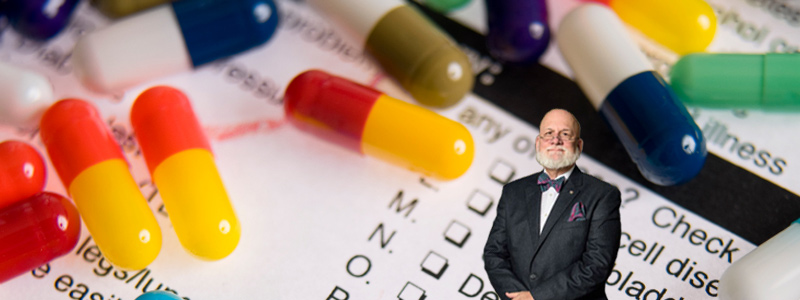There is no doubt that drugs are useful and help us overcome health issues. We’d be dying younger if we didn’t have antibiotics. We’d be living in a society of pain and suffering if we didn’t have pain relievers; ibuprofen, acetaminophen, aspirin, and, YES, the opioid drugs as well.
Often, drugs are an either-or proposition. Either take the pain drug or live with pain, which will diminish when the cause is resolved. Either take the antibiotic, or we suffer from invading bacteria until our body naturally defeats the infection – or we die because of it.
Are we unconcerned?
Becoming complacent about using drugs and chemicals is easy. Our doctors prescribe them and store shelves are loaded to the breaking point with medicines that don’t require prescriptions. They’re”everywhere,” and there’s literally no stigma to taking them daily for years, and a scant few of us even wince at the idea of taking multiple drugs every day for our entire lives.
Drugs offer substantial benefits, but not without a price. They are unnatural substances that users must detoxify and eliminate from our bodies. The primary detoxifying organ is our liver, and our kidneys step up to excrete those toxins. Over time, the adverse effects on the body accumulate, and problems occur more frequently. Time, we recall, is also referred to as aging. The natural decline in body functions is impossible to reverse. What our body could efficiently detoxify when we were 30 becomes a primary task when we’re 60. And, it gets far worse when we add chronic drug use to the natural aging process.
It’s easy and common to “pop a pill”
The drug mentality is so pervasive that a common quest is to find alternatives that offer the benefits of a drug without the side effects; the ones that can occur shortly after taking something and the ones that get worse over time. Begin with the premise that all drugs are unnatural and loaded with deadly side effects and be aware that taking just one dose can be toxic and you will become better at deciding to take the drug.
In an acute situation, the choice can be between swallowing a pill or working through some severe pain, which includes a hefty dose of suffering. Nobody would humanely suggest skipping the pain pill because it will eventually cause other problems. The pain is severe, and it is happening right now. A drug will bring quick relief. In a similar respect, the infection is active and must be treated if life is to be preserved. This isn’t the point of the original post.
When we believe pain drugs are safe and lean toward swallowing them daily for years, we put our body at risk. The top alternative to medication is to discover and eliminate the cause of the pain. In many situations, chronic pain is the result of inflammation. Arthritis, for example, is a diagnosis that means inflammation (“itis”). Some drugs can temporarily reduce inflammation, which returns when the drug is not used. That’s the rub and a primary reason for repeated drug use. The cycle becomes automatic, and it’s simple to turn to other drugs to handle the unwanted side effects of the first one. Problems associated with long term use can escalate when more toxic chemicals bombard the liver. Replacing one drug with another might alter the specific kind of assault, but the attack remains – and is perhaps intensified.
Again, except in acute, immediate situations, the solution is the removal of the cause. When inflammation causes pain, the goal is to eliminate that cause, which often means removing everything that causes inflammation. This is a simple concept that is all but impossible to implement.
Perhaps the CAUSE isn’t a “drug deficiency”
What might cause inflammation? Individual substances are at the core of the problem, but it’s the combination of causes and the daily consumption of them that enhances inflammation, and its associated pain. Chronic use of inflammation-causing substances leads to chronic pain, and that regularly means daily doses of pain pills – and then, their unnatural effects.
Eliminating wheat products, sugars, artificial sweeteners, processed foods, and drugs will reverse the inflamed areas and result in pain relief. Simple! Yet, all but impossible to achieve. It can be accomplished if we decide to eliminate causes and approach the task with reason. Sure, the overall goal is 100% elimination, but any reduction is a step in the right direction. Rather than accept defeat before starting, set a goal to use half of the offending substances. That’s doable. Then shoot for 75%. In time you can learn to survive without so much and the percent eliminated will continue to climb – accompanied by a higher level of health, less pain, and a brighter outlook on living itself.
We don’t have to walk around with a chip on our shoulder when we dine out or get invited to a friendly meal. We don’t need to take a position against the offerings. Instead, we can select the better portions and minimize the items we know will cause a problem. Yes, this means we can enjoy the wedding cake, but taking a few extra pieces is going overboard.
One benefit of this approach will be that items we once thought “needed” extra sweetener will start to taste sweet enough without adding more. Some starchy foods (white potatoes and rice) will actually have a noticeable, natural sweetness to them. Food is more flavorful when we learn to enjoy subtle natural sweetness instead of adding sugar or chemical sweeteners.

